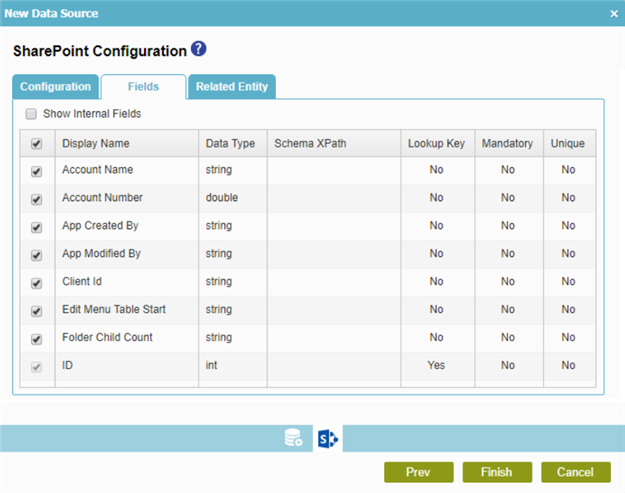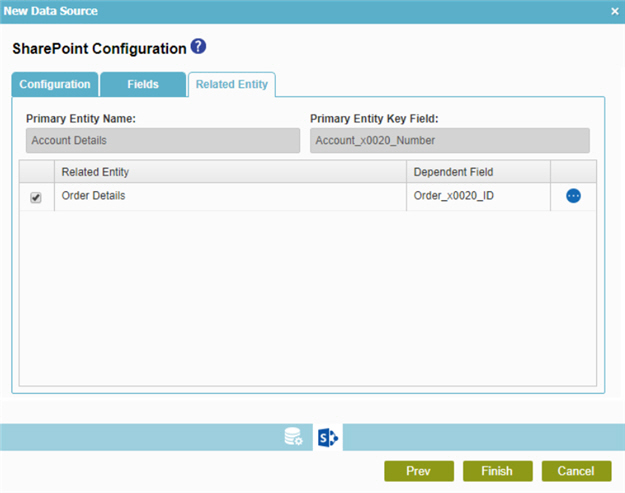Form-Based Application with SharePoint Data Source
This topic shows how to create a form-based app with SharePoint data source.
Examples
- Form Based Applications – SharePoint Data Source
- Examples - Step-by-step use case examples, information about what types of examples are provided in the AgilePoint NX Product Documentation, and other resources where you can find more examples.
Prerequisites
- AgilePoint NX OnDemand (public cloud), or AgilePoint NX PrivateCloud or AgilePoint NX OnPremises v7.0 Software Update 1 or higher.
Good to Know
- The application that uses SharePoint as a data source can only be accessed through the SharePoint Dashboard app or a SharePoint list. When you create a new list item, SharePoint uses the form-based application, instead of the default SharePoint list form.
- By default, the Person or Group column from a SharePoint list is mapped to a People Picker form control, and you can select individual users only. If you want to select both users and groups, you must either change the form control type or create a lookup for the People Picker form control.
- SharePoint does not have a date-only data type. If you configure a
field in SharePoint to show the date only, it is stored in SharePoint
as date-time in UTC format. The regional settings of the SharePoint
site where this value is stored can result in data changes based on the
time zone.
If you want to use time zone conversion for a date-only value in SharePoint, AgilePoint recommends you use a field that is not data-bound. If a SharePoint date-time field is configured to show the date only, a data-bound field will always send an absolute date.
- These time zones are not supported for SharePoint data-bound date-only
fields. If the regional settings for your SharePoint site is
configured to use one of these time zones, you might see a
different date in the SharePoint UI.
- UTC – 11:00 Coordinated Universal Time-11
- UTC – 12:00 International Date Line West
- A New form for SharePoint form-based application does not support attachments. You can add attachments with an Edit form after a list item is created. This is a limitation for new list items in SharePoint.
- A forms-based application that uses a SharePoint data source supports SharePoint lists only. It does not support document libraries. For a SharePoint document library, create a form-based application that uses a different data source, such as Data Entities, and upload documents with metadata to the document library.
- The Standard List Form activity and Start List Form activity can not be used on the lists where forms-based application is created. The List Form activities are only for legacy applications.
- Data binding from eForm controls to a SharePoint list occurs only if a process starts from an application that uses SharePoint as its primary data source. If an eForm is part of a process that starts from SharePoint, it can not use data binding.
How to Start
- Create a form-based application.
- On the New Application screen, click Next.
- On the Select Primary Data Source screen,
select SharePoint
 .
. - Click Next.
SharePoint Configuration screen > Configuration tab
Configures how to collect data from SharePoint for your eForm.

Fields
| Field Name | Definition |
|---|---|
|
Data Source Name |
|
|
SharePoint |
|
|
Add Token |
|
|
Site URL |
|
List Name |
|
SharePoint Configuration screen > Fields tab
Specifies the fields from your SharePoint list to use in your eForm.

Prerequisites
- Complete the SharePoint Configuration screen > Configuration tab.
Fields
| Field Name | Definition |
|---|---|
|
Check box |
|
|
Display Name |
|
|
Data Type |
|
|
Schema XPath |
|
|
Lookup Key |
|
|
Mandatory |
|
|
Unique |
|
SharePoint Configuration screen > Related Entity tab
Specifies the SharePoint list relationships to use in a form-based app.

Prerequisites
- Complete the SharePoint Configuration screen > Configuration tab.
- The Related Entity tab is available if the SharePoint list has a relationship.
Good to Know
- The word entity on this screen refers to a container within your data model. For Data Entities or Salesforce, this container is called an entity. For a database, entity refers to a database table. For SharePoint Integration, entity refers to a SharePoint list.
Fields
| Field Name | Definition |
|---|---|
|
Check box |
|
|
Primary Entity Name |
|
|
Primary Entity Key Field |
|
|
Related Entity |
|
|
Dependent Field |
|
|
Field |
|




